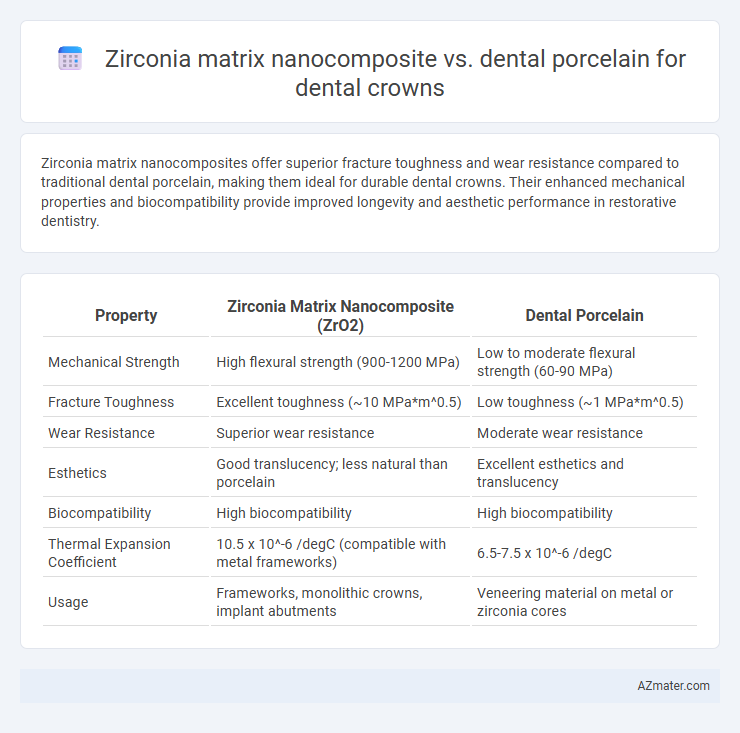Zirconia matrix nanocomposites offer superior fracture toughness and wear resistance compared to traditional dental porcelain, making them ideal for durable dental crowns. Their enhanced mechanical properties and biocompatibility provide improved longevity and aesthetic performance in restorative dentistry.
Table of Comparison
| Property | Zirconia Matrix Nanocomposite (ZrO2) | Dental Porcelain |
|---|---|---|
| Mechanical Strength | High flexural strength (900-1200 MPa) | Low to moderate flexural strength (60-90 MPa) |
| Fracture Toughness | Excellent toughness (~10 MPa*m^0.5) | Low toughness (~1 MPa*m^0.5) |
| Wear Resistance | Superior wear resistance | Moderate wear resistance |
| Esthetics | Good translucency; less natural than porcelain | Excellent esthetics and translucency |
| Biocompatibility | High biocompatibility | High biocompatibility |
| Thermal Expansion Coefficient | 10.5 x 10^-6 /degC (compatible with metal frameworks) | 6.5-7.5 x 10^-6 /degC |
| Usage | Frameworks, monolithic crowns, implant abutments | Veneering material on metal or zirconia cores |
Introduction to Dental Crown Materials
Zirconia matrix nanocomposites exhibit superior mechanical strength and fracture toughness compared to traditional dental porcelain, making them highly suitable for dental crown applications. These nanocomposites offer enhanced wear resistance and biocompatibility, providing durability and esthetic appeal in restorative dentistry. In contrast, dental porcelain is favored for its excellent translucency and natural tooth-like appearance but is more prone to chipping and fracture under occlusal forces.
Overview of Zirconia Matrix Nanocomposite
Zirconia matrix nanocomposite (ZMN) in dental crowns offers superior mechanical strength and fracture toughness compared to traditional dental porcelain, enhancing durability and resistance to chipping. Its nanostructured zirconia particles improve stress distribution and provide excellent wear resistance while maintaining biocompatibility and aesthetic translucency. The advanced material properties of ZMN enable longer-lasting restorations with reduced risk of failure under masticatory forces.
Introduction to Dental Porcelain for Crowns
Dental porcelain is a widely used restorative material for dental crowns due to its excellent esthetic qualities and biocompatibility. It closely mimics the translucency and color of natural teeth, providing a highly aesthetic finish that blends seamlessly with surrounding dentition. Despite its aesthetic advantages, dental porcelain can be brittle and less resistant to fracture compared to Zirconia matrix nanocomposites, which offer superior strength and durability for crown applications.
Mechanical Strength Comparison
Zirconia matrix nanocomposites exhibit superior mechanical strength compared to dental porcelain, with flexural strengths typically exceeding 900 MPa, whereas dental porcelain ranges between 60-120 MPa. The high fracture toughness and enhanced wear resistance of zirconia nanocomposites contribute to their durability under masticatory forces. These properties make zirconia-based crowns more resistant to chipping and cracking compared to the more brittle dental porcelain.
Aesthetic Outcomes: Zirconia Matrix vs Dental Porcelain
Zirconia matrix nanocomposites offer superior translucency and natural tooth color matching compared to traditional dental porcelain, enhancing the aesthetic outcomes for dental crowns. These nanocomposites provide better resistance to staining and maintain their appearance over time, unlike dental porcelain which may dull or discolor. The improved light transmission properties of zirconia matrix materials contribute to a more lifelike and visually appealing restoration.
Wear Resistance and Longevity
Zirconia matrix nanocomposites offer superior wear resistance compared to dental porcelain, reducing surface degradation and maintaining occlusal stability over time. Their enhanced mechanical properties contribute to increased longevity of dental crowns, minimizing the risk of chipping and fracture under masticatory forces. Studies indicate zirconia-based crowns exhibit significantly longer service life due to their robust nano-structured matrix, outperforming traditional porcelain in durability.
Biocompatibility and Patient Safety
Zirconia matrix nanocomposites exhibit superior biocompatibility compared to traditional dental porcelain due to their low plaque accumulation and minimal allergic reactions. Their enhanced fracture toughness reduces the risk of crown failure, promoting patient safety in long-term dental restorations. Dental porcelain, while aesthetically pleasing, may pose higher risks of chipping and wear, potentially compromising periodontal health over time.
Clinical Performance and Success Rates
Zirconia matrix nanocomposites demonstrate superior clinical performance in dental crowns due to their enhanced fracture toughness, wear resistance, and biocompatibility compared to traditional dental porcelain. Studies report higher success rates for zirconia crowns with lower incidences of chipping and structural failures, contributing to improved long-term durability and patient satisfaction. Dental porcelain crowns, while aesthetically pleasing, exhibit increased susceptibility to crack propagation and lower fracture resistance, limiting their clinical lifespan under occlusal stresses.
Cost and Accessibility Considerations
Zirconia matrix nanocomposites are generally more expensive than traditional dental porcelain due to advanced manufacturing processes and material properties, which can increase initial dental crown costs. However, zirconia's enhanced strength and durability often result in longer-lasting restorations, potentially reducing replacement frequency and long-term expenses. Accessibility to zirconia crowns may be limited in some regions due to fewer specialized dental labs and technology requirements, whereas dental porcelain is widely available and more affordable for standard restorative procedures.
Future Trends in Dental Crown Materials
Zirconia matrix nanocomposites demonstrate superior mechanical strength and fracture toughness compared to traditional dental porcelain, promising enhanced durability for dental crowns under high occlusal forces. Advances in nanotechnology continue to improve the bioactivity and aesthetic properties of zirconia-based materials, aligning with the growing demand for lifelike restorations and long-term oral health compatibility. Future trends emphasize the integration of smart biomaterials and digital manufacturing techniques to optimize customization, wear resistance, and patient-specific crown performance.

Infographic: Zirconia matrix nanocomposite vs Dental porcelain for Dental crown
 azmater.com
azmater.com